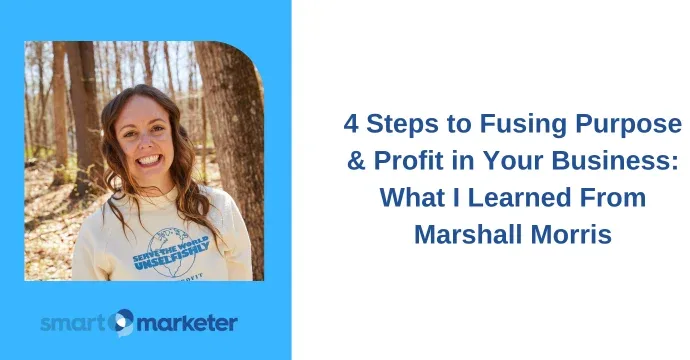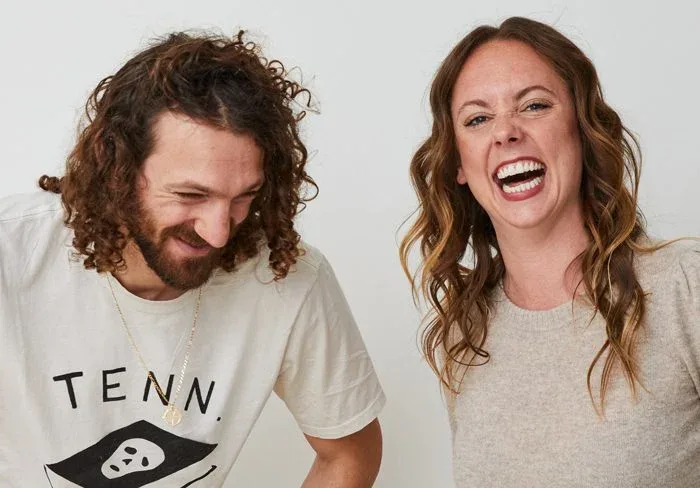
If you know me at all, you know I’m all about bringing soul to your brand and purpose to the daily grind.
In fact, you might be reading this blog post because you’re drawn to Smart Marketer’s mission to “Serve the World Unselfishly and Profit.”
Personally, I think it’s no accident that we’ve succeeded in building several 7- and 8-figure bands, as well as a $200 million Shopify store. I’m convinced our success has a lot to do with this type of “kind capitalism”, as my new friend Marshall Morris calls it.
Is it wrong to want to make a profit? No.
Is it necessary to make a decent profit for a company to survive? Of course.
These questions are no-brainers. But can we do all this AND live a life of purpose?
My stance on this is a resounding YES. And I want to talk about that today because, as an entrepreneur, marketer, and human, you know as well as I do that it’s not that easy to do.
So, how do we build profitable businesses that are wrapped in purpose?
I recently met Marshall Morris and had the chance to sit down and talk with him on the Smart Marketer Podcast.
He’s a super successful business owner who shares my passion for purpose-driven entrepreneurship, but Marshall approaches business a little differently than most, and I loved hearing all about it.
I’m more convinced than ever that this is the way forward for all of us. As Marshall says:
“If we can think creatively, I think businesses have the power to solve most of the problems in this world.”
So, who is Marshall Morris?
Marshall is the Inc 500 Founder of HomeLife Media, a portfolio of ecommerce and media brands that focus on people and their pets. They’ve donated over $1 million to veterans with PTSD and have fed over 30 million shelter pets, which is amazing.
We instantly connected and had a thousand things to talk about, because with every brand or company that he launches, he builds it around a purpose.
And I think this is more important than ever. If our businesses don’t have soul, they’re not going to survive (let alone thrive).
If you want to fuse purpose and profit in your business, then follow these 4 steps from the great Marshall Morris.
Step 1: Build Your Audience First
I mentioned before that Marshall builds businesses differently than most. He does something so few entrepreneurs think to do: he builds the audience and the community first before trying to sell products or services.
A mistake I see so often is entrepreneurs who fall in love with their product and spend their days trying to figure out how to sell it, thinking that a new marketing strategy or tactic can save them.
It reminds me of that old Kevin Costner movie, Field Of Dreams, where he follows the voice that tells him, “If you build it they will come.” Now, in the movie (spoiler alert), it works out for him. But that’s not always the best strategy.
Instead, take a leaf out of Marshall’s book and build (or find) a community first, then dive into it and get to work understanding their passions, needs, and, most of all, what they care about deeply.
Marshall calls these Passion Groups:
“There are a lot of people who self-congregate in Passion Groups online. One of the things we noticed early that was so powerful was pets. People just love to talk with their pets. They love to share their photos.
And that’s one signal that there is a strong community: when there are already existing communities built by “super users” or moderators without any commercial intent. It’s happening naturally.
And so we said, ‘Okay, what happens if we layer in here?’ So we started experimenting with how to get people together online, and then we just started watching conversations.“
I love this. Honestly, when I look at our clients that are scaling and growing and seeing the most success, most of them are either selling to:
- Pet owners (a very big passion market, obviously)
- Parents
- Or people with businesses
All of these groups are passionate, and products that truly serve them tend to do great.
“We have a portfolio of companies not because we go out and acquire them, but just because we find a product or service, and we find a purpose.
And those things sometimes have a life of their own, and we just allow them to kind of expand and run their own race.”
When you know what your customers deeply care about, you can go beyond pitching them products. You can actually ask yourself, “What could we do together to make an impact?”
You can take your community along with you as you solve real-world problems. You can dream big!
Let’s dive into that.
Step 2: Tie Your Business to a Greater Purpose
For Marshall, his first venture in this direction was pairing the passion in his dog group with his own desire to help veterans.
As a vet himself, Marshall started to see the impact of PTSD in people who had been in wartime scenarios, and then learned about the miraculous power of service dogs to help them.
So he launched a brand selling veteran-themed jewelry and started funding service dogs for veterans.
“It took on a life of its own and became The Hero Company.
It’s almost like magic. There’s nothing I’ve seen that helps these guys and gals more than the service animal, especially when they need it.
It just changes their life, changes their family. It’s just incredible.”
And The Hero Company is now on track to become a $10 million brand in the next year or two!
What can you learn from this?
If you want to have a meaningful community and a purposeful business, you need to provide a great product at a fair price (obviously) while also allowing people to be part of a more significant impact.
This is key to your success — not just in growing your business but also in growing your impact. So that’s what I want to explore next.
How do we bring our customers along for the journey?
Step 3: Don’t Stop at Donating a Percentage
So many companies are trying to give back, right?
But we’re talking about taking it a step further than just giving a percentage of your profits, or selling one product that goes to a cause.
These are good ideas, but what we want to do is truly fuse our identity with the impact we want to have.
Marshall never donates a percentage of his sales. Instead, he’s found that the secret sauce is when you can make “the giving back” extremely measurable and tangible to the customer.
“There are two components to giving back: one is the actual impact you are having, and the other is the story you can tell, which is really important too.”
For example: instead of saying “We will give 10% to this orphanage,” you could say, “With every purchase, you fund one meal for an orphan.”
It’s powerful when you can get the consumer focused on what the real Impact is — not the monetary amount. I mean, would you rather “Donate $10” or “Keep the heat on for a family for a whole week?”
For Kentucky Saving Them Together, I calculated that it costs about $500 to save a dog from euthanasia. When we started incorporating that figure into our messaging, we saw an immediate increase in the number of people who were willing to donate funds.
So, guys, you have to get creative and tell the story in a more powerful way. Quantify exactly what someone’s purchase provides. How can you frame what you’re doing so that your customer feels more invested (and rewarded)?
When you get this right, it’s the sweet spot. It brings out the best in people.
Step 4: Partner with a Nonprofit
To close out this conversation, I just want to acknowledge that in my journey with the shelter, I’ve experienced just how much work it is to run a nonprofit — like, it’s no joke!
I’ve also met so many of you who want to have an impact but feel daunted by the idea of starting a 501(c)(3) with all the rules and regulations (on top of everything else you do).
So I love Marshall’s take on this.
“We don’t have a nonprofit in-house. We’re great marketers and product builders, and that’s where we want to keep our head in the game.
But some people manage these funds really well, and part of Stewardship and making an impact (and this is what your consumers and the end-users of your community deserve) is ensuring the funds are being used well, right?
So we found that a lot of nonprofits are really great at on-the-ground work, but they’re not that great at fundraising. So we raise the money and donate it to nonprofits who are spending all their time managing the resources well”.
It makes so much sense to stay in your lane.
There’s nothing more rewarding than pairing your marketing skills with the communities you build to identify and solve real-world problems.
Plus, as Marshall has shown us, businesses built around a purpose have an organic energy that feels like the wind at your back.
And who doesn’t want that?
I’d love to hear about what you’re doing (or want to do) in your business. Or if, like me, you’re using your marketing skills on the side to help a good cause, we’d love to hear about that, too!
Reach out to me on Instagram at @mollypittmandigital, or write in to help@smartmarketer.com.
Thanks for reading!




